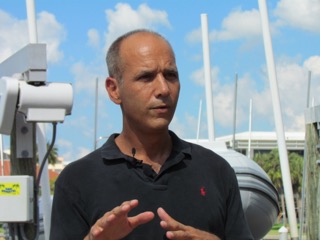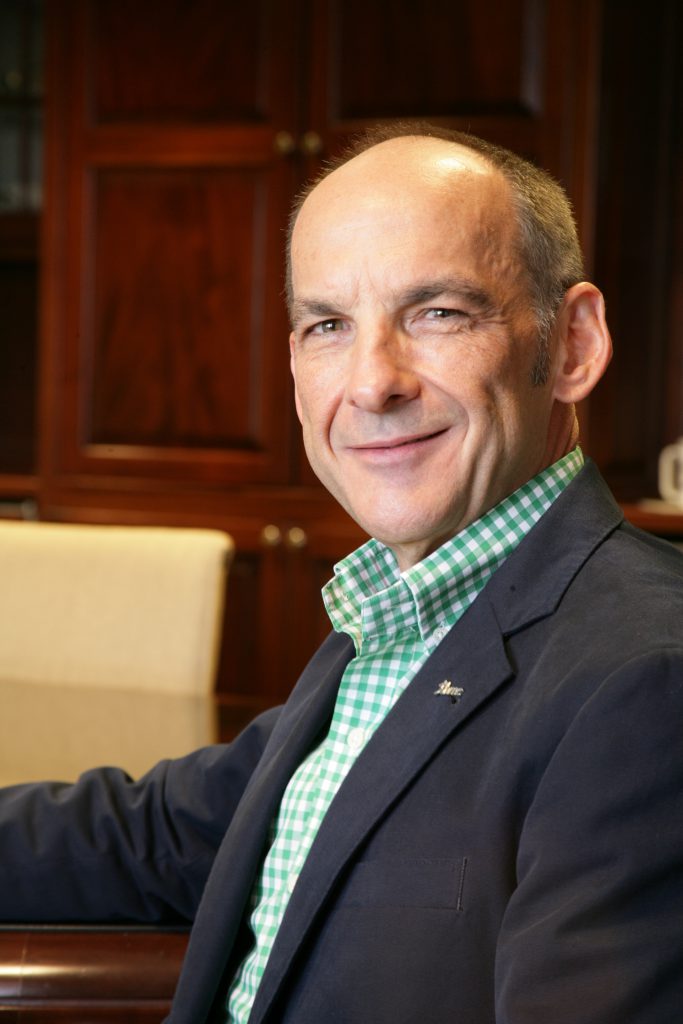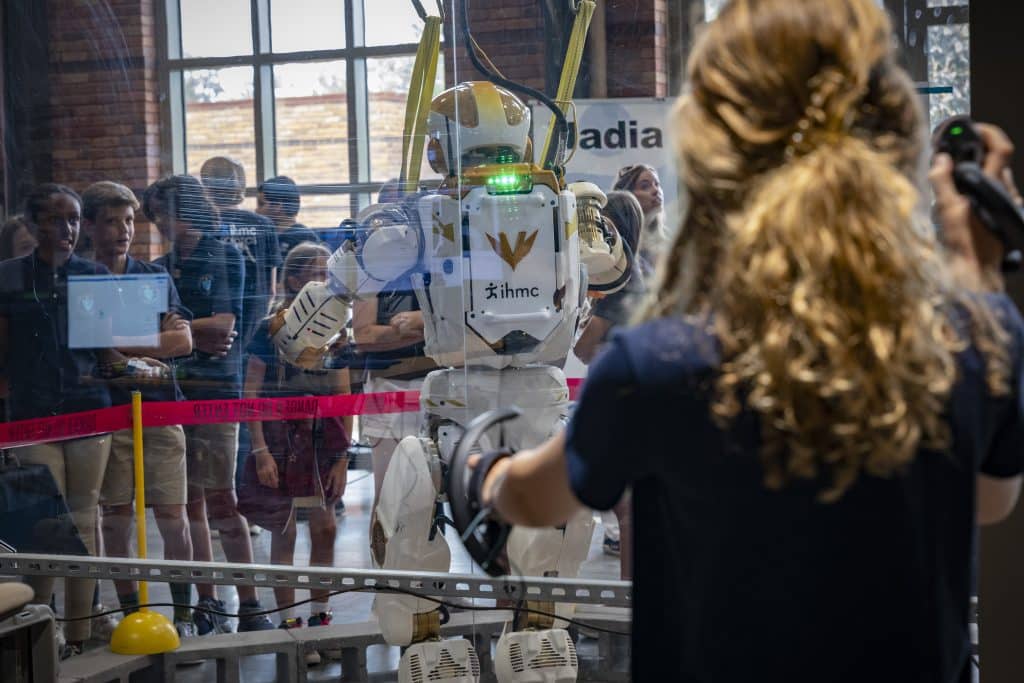Undersea Technology Expert David Fries Joins IHMC
 The day that a tree can talk—telling you about its ancestry and physical composition, and the air it breathes—is the future that David Fries envisions.
The day that a tree can talk—telling you about its ancestry and physical composition, and the air it breathes—is the future that David Fries envisions.
“Rather than sit in a classroom where you have representations of a tree on a white board, you are actually in proximity of the tree and can see visualizations of its chemistry, biology and sustainability,” Fries said.
In practice, this means that a mobile device could see a tree and then start tracing the flow of nutrients from its roots to its branches.
This “fusion of education and entertainment,” Fries said, is one area that he intends to work on as a recently-hired research scientist at the Florida Institute for Human and Machine Cognition (IHMC). The Tampa-based scientist, who has been on faculty at the University of South Florida for two decades, will work at both the Ocala and Pensacola IHMC locations until next summer, when he re-locates to Pensacola.
Fries’ main area of specialization is undersea technology. He holds 35 patents in the field, and is best known for inventing underwater sensors and robots that can determine the extent of oil spill contamination, detect submarines (or other robots), and help take fish counts.
The potential benefits of using such devices are economic, political and ecological.
To take just one example, accurate fish counts via robots (as opposed to using humans on boats, which cause the fish to scatter) can help a state like Florida, with 1,200 miles of coastline, manage recreational fishing.
“Knowing accurately how much is there is important for knowing how long to keep a season open,” and whether or not fish stock enhancements like fingerlings should be put out, Fries said.
“The open question is does that really help a population, or are there more effective strategies to use?” Fries added.
Functional implications aside, these underwater technologies provide us with “an underwater learning cloud,” Fries said. “The ocean begins to tell you its secrets.”
Fries said he looks forward to collaborating with other IHMC scientists focused on the underwater world, such as Dawn Kernagis, who works on risk mitigation for divers and understanding the genetic and physiological factors that can make divers prone to the bends.
“I could see projects emerging between Dawn and I,” Fries said. “I look at myself as a “technology” toolmaker. It’s hard to do good science without these tools, and science questions help drive tool development. There’s a dance between the two.”
IHMC CEO/Director Ken Ford said Fries will be a great addition to the team. “David Fries is a true innovator in undersea technologies. We are thrilled to have him,” Ford said.
He feels IHMC is open to accommodating his creative endeavors as they relate to his pursuit of science. “I tend to be a little out of the box,” Fries said.
Fries has collaborated with a Dutch artist in an exhibit on biomorphic patterns at the Dali Museum in St. Petersburg, and the Schmidt Ocean Institute is supporting his work on using data from the ocean to influence visualizations in live public performances.
“I’d like to continue to look at oceans and technology for art exploration,” Fries said. “The science can inform the art, and the art can inform science.”
Fries also has a practical, entrepreneurial side and enjoys engaging in research that fosters economic development. He has spearheaded several spin-offs from his research already.
“I hope to guide/shepherd some innovations towards economic development out of IHMC in the community,” Fries said. “I really get a thrill of taking an idea and turning it into something and then someone ultimately having a job related to it.”
Fries is originally from Pittsburgh—an “urban street urchin,” he calls himself. But he was smitten by the natural world as soon as he started exploring it.
“When I got into woods and saw another world besides concrete jungle, it excited me,” Fries said. “I ended up being in the blue space instead of the green space, and it’s been a wonderful ride.”
Fries said his work is so engaging, that he doesn’t really have time for hobbies, apart from longboarding to and from work, typically a 5-mile commute roundtrip.
“I’m a 14-year-old kid at heart,” he said.
Ken Ford named AAAS Fellow
 The American Association for the Advancement of Science (AAAS) has elected Ken Ford, director and CEO of the Florida Institute for Human and Machine Cognition (IHMC), as a Fellow.
The American Association for the Advancement of Science (AAAS) has elected Ken Ford, director and CEO of the Florida Institute for Human and Machine Cognition (IHMC), as a Fellow.
Ford is one of 347 scientists who have been named Fellows this year. The electing Council elects people “whose efforts on behalf of the advancement of science of its applications are scientifically or socially distinguished.”
According to a press release from AAAS, Ford was selected “for founding and directing the IHMC, for his scientific contributions to artificial intelligence and human-centered computing, and for service to many federal agencies.”
“I am truly honored to be inducted as an AAAS Fellow,” Dr. Ford said. “The advancement of science is what we strive for every day at IHMC; to be recognized for it by scientists is a reward in itself.”
IHMC, which Ford founded in 1990, is known for its groundbreaking research in the field of artificial intelligence. It employs scientists and engineers from around the world who are investigating topics related to building technological systems aimed at amplifying and extending human cognitive, physical and perceptual capacities. Its headquarters are in Pensacola, Fla., with an associated research facility in Ocala, Fla.
Ford himself is a renowned artificial intelligence researcher. He holds numerous awards and honors, including the Association for the Advancement of Artificial Intelligence (AAAI) Distinguished Service Award.
He has also served on the National Science Board, chaired the NASA Advisory Council and served on the U.S. Air Force Science Advisory Board and the Defense Science Board.
AAAS began electing Fellows in 1874. The AAAS chief executive officer, or AAAS members elect Fellows. There are an estimated 100,000 AAAS members.
Ford and the other Fellows will receive an official certificate and a gold and blue rosette pin on Saturday, February 13 at the AAAS Fellows Forum during the 2016 Annual Meeting in Washington, D.C.
Robotics Open House
Open House at IHMC – Thursday, April 11, 2024
To celebrate the National Robotics Week, IHMC researchers will welcome the public from 3 to 7 p.m. April 11, 2024, for an Open House in hopes of inspiring young people to pursue careers in science, technology, engineering, and math.
The family-friendly event encourages scientific discovery through hands-on activities, challenges, and demonstrations while providing the opportunity to learn about robots from IHMC’s researchers and educators.
National Robotics Week is all about celebrating robotics technology and development and inspiring students of all ages to pursue careers in these areas. At Open House, our team will demonstrate kid-friendly robotics concepts and real-world applications including robotics, virtual reality experiences and more. The last tour begins at 6:30 p.m.
Established by Congress in 2010 to raise awareness about robots and their important role in shaping the future of education, industry, and the U.S. economy, National Robotics Week brings together students, educators, and influencers who share a passion for robots and technology.


